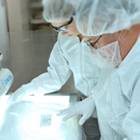BIOSENSIS PTY
Artikel-Nr:
(BSENM-1802-50)
Lieferant:
Biosensis
Hersteller-Artikelnummer::
M-1802-50
Lokale Artikelnummer::
BSENM-1802-50
Beschreibung:
May participate in RNA metabolism in the myelinating cell, CNP is the third most abundant protein in central nervous system myelin. Ref: uniprot.org
VE:
1 * 50 µG
Artikel-Nr:
(BSENR-182-250)
Lieferant:
Biosensis
Hersteller-Artikelnummer::
R-182-250
Lokale Artikelnummer::
BSENR-182-250
Beschreibung:
Ubiquitin is a highly conserved 76 amino acid protein with an estimated molecular weight of 8.56 kDa which has a central role in regulated protein degradation. It is a protein modifier which can be covalently attached to target lysines either as a monomer or as a lysine-linked polymer. Several types of polymeric chains can be formed depending on the lysine used for the assembly. Attachment to proteins as a polymer leads to their degradation by the 26S proteosome; a complex, multicatalytic cytosolic and nuclear protease. Attachment to proteins as a monomer or as an alternatively linked polymer does not lead to proteasomal degradation and may be required for numerous functions, including maintenance of chromatic structure, regulation of gene expression, stress response, ribosome biogenesis and DNA repair. Ubiquitin is synthesized as a polyubiquitin precursor with exact head to tail repeats, the number of repeats of which differ between species and strains. In some species there is a final amino-acid after the last repeat, here in bovine a Cys. Some ubiquitin genes contain a single copy of ubiquitin fused to a ribosomal protein (either L40 or S27a).
VE:
1 * 250 µG
Artikel-Nr:
(BSENR-1717-50)
Lieferant:
Biosensis
Hersteller-Artikelnummer::
R-1717-50
Lokale Artikelnummer::
BSENR-1717-50
Beschreibung:
Anti-TrkB (phospho Y816/Y817) Rabbit Polyclonal Antibody
VE:
1 * 50 µG
Artikel-Nr:
(BSENS-045-50)
Lieferant:
Biosensis
Hersteller-Artikelnummer::
S-045-50
Lokale Artikelnummer::
BSENS-045-50
Beschreibung:
FUNCTION: Nuclear phosphoprotein which forms a tight but non-covalently linked complex with the JUN/AP-1 transcription factor. Has a critical function in regulating the development of cells destined to form and maintain the skeleton. It is thought to have an important role in signal transduction, cell proliferation and differentiation. SUBUNIT: Heterodimer. Interacts with DSIPI; this interaction inhibits the binding of active AP1 to its target DNA. Interacts with MAFB. SUBCELLULAR LOCATION: Nucleus. INDUCTION: C-fos expression increases upon a variety of stimuli, including growth factors, cytokines, neurotransmitters, polypeptide hormones, stress and cell injury. SIMILARITY: Belongs to the bZIP family. Fos subfamily. SIMILARITY: Contains 1 bZIP domain
VE:
1 * 50 µG
Artikel-Nr:
(BSENR-184-100)
Lieferant:
Biosensis
Hersteller-Artikelnummer::
R-184-100
Lokale Artikelnummer::
BSENR-184-100
Beschreibung:
FUNCTION: Promotes microtubule assembly and stability, and might be involved in the establishment and maintenance of neuronal polarity. The C-terminus binds axonal microtubules while the N-terminus binds neural plasma membrane components, suggesting that tau functions as a linker protein between both. Axonal polarity is predetermined by tau localization (in the neuronal cell) in the domain of the cell body defined by the centrosome. The short isoforms allow plasticity of the cytoskeleton whereas the longer isoforms may preferentially play a role in its stabilization. SUBCELLULAR LOCATION: Cytoplasm; cytosol. Cell membrane. Mostly found in the axons of neurons, in the cytosol and in association with plasma membrane components. ALTERNATIVE PRODUCTS: 8 named isoforms produced by alternative splicing. Additional isoforms seem to exist. Isoforms differ from each other by the presence or absence of up to 5 of the 15 exons. One of these optional exons contains the additional tau/MAP repeat. TISSUE SPECIFICITY: Expressed in neurons. Isoform PNS-tau is expressed in the peripheral nervous system while the others are expressed in the central nervous system. DEVELOPMENTAL STAGE: Four-repeat (type II) tau is expressed in an adult-specific manner and is not found in fetal brain, whereas three-repeat (type I) tau is found in both adult and fetal brain. DOMAIN: The tau/MAP repeat binds to tubulin. In Alzheimer disease, the neuronal cytoskeleton in the brain is progressively disrupted and replaced by tangles of paired helical filaments and straight filaments, mainly composed of hyperphosphorylated forms of Microtubule-associated protein Tau. Defects in Microtubule-associated protein Tau are a cause of frontotemporal dementia and parkinsonism linked to chromosome 17, as well as a number of other neurodegenerative diseases.
VE:
1 * 100 µl
Artikel-Nr:
(BSENM-1689-100)
Lieferant:
Biosensis
Hersteller-Artikelnummer::
M-1689-100
Lokale Artikelnummer::
BSENM-1689-100
Beschreibung:
Anti-LMNA Mouse T4 Antibody [clone: 4C4]
VE:
1 * 100 µG
Artikel-Nr:
(BSENR-1686-500)
Lieferant:
Biosensis
Hersteller-Artikelnummer::
R-1686-500
Lokale Artikelnummer::
BSENR-1686-500
Beschreibung:
Nicastrin, a type 1 membrane glycoprotein, is an essential component of the gamma secretase complex which is critical for the cleavage of the amyloid precursor protein and other membrane proteins. Nicastrin is widely expressed in different tissue types. This antibody detects all processed forms of Nicastrin.
VE:
1 * 500 µG
Artikel-Nr:
(BSENC-1698-100)
Lieferant:
Biosensis
Hersteller-Artikelnummer::
C-1698-100
Lokale Artikelnummer::
BSENC-1698-100
Beschreibung:
The Lamin proteins are members of the intermediate filament protein family but are located inside the nucleus rather than in the cytoplasm (1). The lamins function as skeletal components tightly associated with the inner nuclear membrane. Originally the proteins of the nuclear cytoskeleton were named Lamin A, B and C, from top to bottom as visualized on SDS-PAGE gels. Subsequently it was found that Lamins A and C were coded for by a single gene (2), while the Lamin B band may contain two proteins encoded by two genes now called Lamin B1 and Lamin B2. Lamin A has a mass of about 74kDa while Lamin C is 65kDa. The Lamin A protein includes 98 amino acids missing from Lamin C, while Lamin C has a C-terminal 6 amino acid peptide not present in Lamin A. Apart from these regions Lamin A and C are identical so that antibodies raised against either protein are likely to cross react with the other, as is the case with this monoclonal. Lamin polymerization and depolymerization is regulated by phosphorylation by cyclin dependent protein kinase 1 (CDK1), the key component of "maturation promoting factor", the central regulator of cell division. Activity of this kinase increases during cell division and is responsible for the breakdown of the nuclear lamina. Mutations in the LMNA gene are associated with several serious human diseases, including Emery-Dreifuss muscular dystrophy, familial partial lipodystrophy, limb girdle muscular dystrophy, dilated cardiomyopathy, Charcot-Marie-Tooth disease type 2B1, and Hutchinson-Gilford progeria syndrome. This family of diseases belong to a larger group which are often referred to as Laminopathies, though some laminopathies are associated in defects in Lamin B1, B2 or one or other of the numerous nuclear lamina binding proteins. A truncated version of lamin A, commonly known as progerin, causes Hutchinson-Gilford progeria syndrome, a form of premature aging (3).
VE:
1 * 100 µl
Artikel-Nr:
(BSENM-027-50-AT)
Lieferant:
Biosensis
Hersteller-Artikelnummer::
M-027-50-AT
Lokale Artikelnummer::
BSENM-027-50-AT
Beschreibung:
Anti-TNR16 Mouse Monoclonal Antibody [clone: Clone: Me20.4] (Atto 488)
VE:
1 * 50 µG
Artikel-Nr:
(BSENC-1535-500)
Lieferant:
Biosensis
Hersteller-Artikelnummer::
C-1535-500
Lokale Artikelnummer::
BSENC-1535-500
Beschreibung:
Presenilin-2 (PSEN2) is a multi-pass membrane protein and component of the gamma-secretase complex. Defects in PSEN2 are a cause of Alzheimer disease type 4 (AD4), an autosomal dominant Alzheimer disease. (Ref:SWISS-Prot).
VE:
1 * 500 µl
Artikel-Nr:
(BSENR-1497-50)
Lieferant:
Biosensis
Hersteller-Artikelnummer::
R-1497-50
Lokale Artikelnummer::
BSENR-1497-50
Beschreibung:
Human Gastrin is a 101 amino acid hormone produced by G cells of the duodenum, stomach and pancreas. It stimulates secretion of hydrochloric acid by parietal cells of the stomach. Gastrin is also secreted into bloodstream.
VE:
1 * 50 µG
Artikel-Nr:
(BSENR-1389-50)
Lieferant:
Biosensis
Hersteller-Artikelnummer::
R-1389-50
Lokale Artikelnummer::
BSENR-1389-50
Beschreibung:
Neurofilaments contain three intermediate filament proteins: light (68 kDa), medium (160 kDa) and heavy (200 kDa). Neurofilament heavy (NF200 or NF-H) is phosphorylated and it is thought that this results in the formation of interfilament cross bridges that are important in the maintenance of axonal caliber.
VE:
1 * 50 µl
Artikel-Nr:
(BSENS-054-500)
Lieferant:
Biosensis
Hersteller-Artikelnummer::
S-054-500
Lokale Artikelnummer::
BSENS-054-500
Beschreibung:
NT3 is a member of the neurotrophin family, that controls survival and differentiation of visceral and proprioceptive sensory neurons. NT3 is closely related to both NGF and BDNF. It may be involved in the maintenance of the adult nervous system, and may affect development of neurons in the embryo when it is expressed in human placenta. NT3-deficient mice generated by gene targeting display sevvere movement defects of the limbs. The mature peptide of this protein is identical in all mammals examined including human, pig, rat and mouse. SUBCELLULAR LOCATION: Secreted protein. TISSUE SPECIFICITY: Brain and peripheral tissues. SIMILARITY: Belongs to the NGF-beta family.
VE:
1 * 500 µG
Artikel-Nr:
(BSENR-137-500)
Lieferant:
Biosensis
Hersteller-Artikelnummer::
R-137-500
Lokale Artikelnummer::
BSENR-137-500
Beschreibung:
FUNCTION: Required for autophagy. SUBUNIT: Conjugated to ATG5. SUBCELLULAR LOCATION: Cytoplasm. ALTERNATIVE PRODUCTS: 2 named isoforms produced by alternative splicing. TISSUE SPECIFICITY: Ubiquitous. SIMILARITY: Belongs to the ATG12 family.
VE:
1 * 500 µG
Artikel-Nr:
(BSENBL-005-500)
Lieferant:
Biosensis
Hersteller-Artikelnummer::
BL-005-500
Lokale Artikelnummer::
BSENBL-005-500
Beschreibung:
HETEROPHILIC AB BLOCKER FOR BEK-2212 1 * 500 G
VE:
1 * 500 µG
Artikel-Nr:
(BSENBL-003-1000)
Lieferant:
Biosensis
Hersteller-Artikelnummer::
BL-003-1000
Lokale Artikelnummer::
BSENBL-003-1000
Beschreibung:
HETEROPHILIC AB BLOCKER BEK-2212+BEK-221 1 * 1.000 G
VE:
1 * 1.000 µG
Preis auf Anfrage
Lager für diesen Artikel ist begrenzt, kann aber in einem Lagerhaus in Ihrer Nähe zur Verfügung. Bitte stellen Sie sicher, dass Sie in sind angemeldet auf dieser Seite, so dass verfügbare Bestand angezeigt werden können. Wenn das
Lager für diesen Artikel ist begrenzt, kann aber in einem Lagerhaus in Ihrer Nähe zur Verfügung. Bitte stellen Sie sicher, dass Sie in sind angemeldet auf dieser Seite, so dass verfügbare Bestand angezeigt werden können. Wenn das
Dieses Produkt kann nur an eine Lieferadresse versandt werden die über die entsprechende Lizenzen verfügt. Für weitere Hilfe bitte kontaktieren Sie Ihr VWR Vertriebszentrum.
-Additional Documentation May be needed to purchase this item. A VWR representative will contact you if needed.
Dieses Produkt wurde von Ihrer Organisation gesperrt. Bitte kontaktieren Sie Ihren Einkauf für weitere Informationen.
Dieses Produkt ist Ersatz für den von Ihnen gewünschten Artikel.
Dieses Produkt ist nicht mehr verfügbar. Bitte kontaktieren Sie den VWR Kundenservice.
|
|||||||||

















































